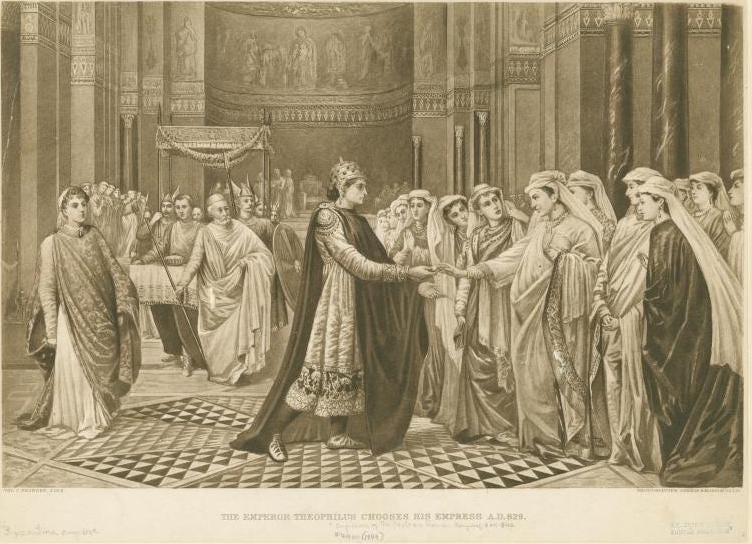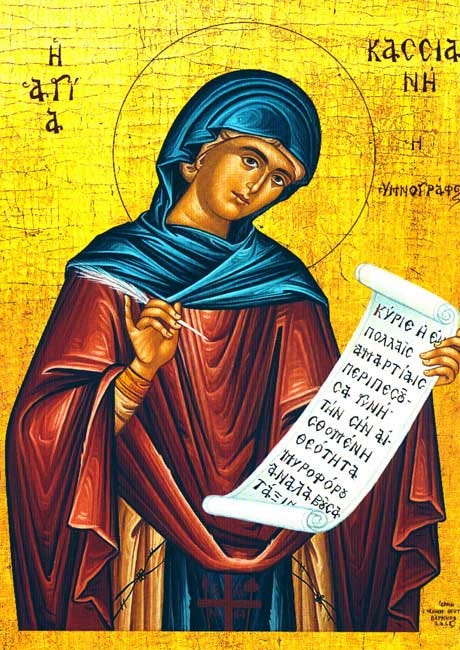St. Kassia
Discover the legacy of St. Kassia, the remarkable 9th-century Byzantine nun who became one of the first known female composers in Western music history.
The Selection of an Empress
Smoke of ceremonial incense hung heavy in the vast chamber. A gathering of beautiful, young brides stood huddled together in the center of the room. Their nervous laughter and soft words echoed off the stone palace walls. These women of the realm were daughters of the influential class, seeking the hand of the next Emperor, Theophilos. Around the women stood their families, all with high aspirations, quietly chatting in anticipation for the arrival of the prince.
The heavy doors opened and silenced the room. The prince himself slowly approached the group of girls with an air of solemnity, examining each of them in all their finery as he approached. The tension in the room was palpable. Each woman held her breath, hoping for the golden apple's touch—a symbol of imperial favor and a destiny entwined with power. Theophilos was stricken at once by the exotic beauty of one of the maidens. Approaching her, golden apple in hand, he spoke:
“Ἐκ γυναικὸς τὰ χείρω.” “Through a woman [came forth] the baser [things].”
“Kαὶ ἐκ γυναικὸς τὰ κρείττω." “And through a woman [came forth] the better [things],” came her prompt reply.
Shaken, he withdrew from the beauty and moved on to another—to one who might show more deference towards the future emperor.
St. Kassia’s Legacy in Music and Faith
According to three Byzantine chroniclers, the woman from the above passage who came close to becoming the wife of Theophilos, was a woman named Kassia. She was born sometime in the early ninth century, sometime between 805 and 810. She came from a wealthy family in Constantinople, and she possessed an intellect that matched her famed beauty. She leaves a legacy as one of the earliest, if not the first of, recorded female composers.
Though many infer her rejection by Theophilos to be the causal event that pushed Kassia to seek a spiritual life, Theodore the Studite expressed contradictory views, stating she had possessed other desires for seeking such a life—though it very much could have played a role in her choice. As a young woman in Constantinople, she went on to found a convent near the western walls of the city. Kassia was named the first Abbess of this convent, built on Xerolophos, which was the seventh hill of Constantinople. Here she partnered with the neighboring monastery Stoudios, where they jointly played a central role in re-editing the Byzantine liturgical books during the 9th and 10th centuries. This effort ensured that her work would be recorded.
Early on, Kassia had shown musical talent as a young girl. Her reputation caught the attention of Theodore the Studite, who regarded Kassia as an “exceptional and rare phenomenon.” During her youth, Kassia wrote spiritual poetry but also went a step further with her art: she composed music to accompany it. She went on to develop this musical talent and became a composer and hymnographer. To this day, at least 24 hymns can be directly attributed to her, all known as stichera—hymns sung during daily evening vespers or during early morning offices and other services of the Orthodox Church. Many more works exist with attribution to Kassia, but it is less certain whether they are truly her compositions as other publications of the same pieces lack direct attribution ala “anonymous” or in some cases, attribute the pieces to other composers.
Veneration of icons
In addition to her musical contributions to the Orthodox Church, Kassia was an outspoken advocate for the veneration of icons during the second iconoclasm that had continued under the reign of emperor Theophilos. Her stance against the imperial edict calling for the destruction of religious iconography found her persecuted and once subject to lashing.
As a writer of gnomic poetry and epigrams, she quite often embodied her writings, plainly stating in one of these many verses: "I hate silence, when it is time to speak." Kassia eventually fled the continued persecution of iconodules, spending a brief time in Italy before settling on the Greek island of Kasos, where she remained until her death.
Enjoying early music? Please share this newsletter to help spread the good vibes :)
The Hymn of Kassia
Perhaps her most famous of hymns, the origin of the Hymn of Kassia is intertwined with what may either be legend, fact, or some mix of both:
“Tradition says that in his later years the Emperor Theophilus, still in love with her, wished to see her one more time before he died, so he rode to the monastery where she resided. Kassia was alone in her cell, writing her Hymn when she realized that the commotion she heard was because the imperial retinue had arrived. She was still in love with him but was now devoted to God and hid away because she did not want to let her old passion overcome her monastic vow. She left the unfinished hymn on the table. Theophilus found her cell and entered it alone. He looked for her but she was not there; she was hiding in a closet, watching him. Theophilus, overcome with sadness, cried and regretted that moment of pride when he rejected such a beautiful and intellectual woman; then he noticed the papers on the table and read them. When he had finished reading, he sat and added one line to the hymn; then he left. The line attributed to the Emperor is the line "those feet whose sound Eve heard at dusk in Paradise and hid herself for fear." Legend says that as he was leaving he noticed Kassia in the closet but did not speak to her, out of respect for her wished privacy. Kassia emerged when the emperor was gone, read what he had written and finished the hymn.”
—Zugravu, Gheorghita (2013). Kasia the Melodist. And the Making of a Byzantine Hymnographer
This Byzantine hymn is characterized by its slow, mournful melody. It demands an exceptionally wide vocal range, earning it a reputation as one of the most challenging pieces in the Byzantine chant repertoire. Skilled cantors regard a proficient rendition of this hymn as a significant accomplishment. While primarily a solo piece, it is occasionally performed by choirs in unison, often accompanied by a distinctive Byzantine bass drone. The hymn's complexity and emotional depth make it a noteworthy example of the Byzantine musical tradition.
Hymn of St. Kassia Lyrics
O Lord, the woman who had fallen into many sins, perceiving Thy Divinity, fulfilled the part of a myrrh-bearer; and with lamentations she brought sweet-smelling oil of myrrh to Thee before Thy burial. 'Woe is me,' she said, 'for night surrounds me, dark and moonless, and stings my lustful passion with the love of sin. Accept the fountain of my tears, O Thou Who drawest down from the clouds the waters of the sea. Incline to the groanings of my heart, O Thou Who in Thine ineffable self-emptying hast bowed down the heavens. I shall kiss Thy Most Pure feet and wipe them with the hairs of my head, those feet whose sound Eve heard at dusk in Paradise and hid herself for fear. Who can search out the multitude of my sins and the abyss of Thy judgments, O Savior of my soul? Despise me not, Thine handmaiden, for Thou hast mercy without measure.
Reflecting on St. Kassia’s Legacy
Kassia’s legacy transcends her time, reminding us that true artistry and faith are timeless. Her hymns not only uplift the spirit but also stand as a testament to the enduring power of voice and verse. As you listen to her music, may you find the same solace and inspiration that generations have cherished.






